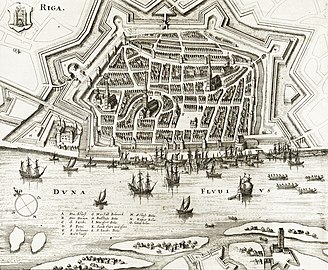Vecrīga
- View a machine-translated version of the Latvian article.
- Machine translation, like DeepL or Google Translate, is a useful starting point for translations, but translators must revise errors as necessary and confirm that the translation is accurate, rather than simply copy-pasting machine-translated text into the English Wikipedia.
- Do not translate text that appears unreliable or low-quality. If possible, verify the text with references provided in the foreign-language article.
- You must provide copyright attribution in the edit summary accompanying your translation by providing an interlanguage link to the source of your translation. A model attribution edit summary is
Content in this edit is translated from the existing Latvian Wikipedia article at [[:lv:Vecrīga]]; see its history for attribution. - You may also add the template
{{Translated|lv|Vecrīga}}to the talk page. - For more guidance, see Wikipedia:Translation.
Vecrīga | |
|---|---|
Neighbourhood of Riga | |
| Vecpilsēta | |
 The Old Town of Riga | |
 Location of Vecpilsēta in Riga | |
| Country |  Latvia Latvia |
| City |  Riga Riga |
| District | Central District |
| Area | |
| • Total | 0.944 km2 (0.364 sq mi) |
| Population (2017) | |
| • Total | 3,336 |
| • Density | 3,500/km2 (9,200/sq mi) |
| Website | apkaimes.lv |
UNESCO World Heritage Site | |
| Official name | Historic Centre of Riga |
| Type | Cultural |
| Criteria | ii, i |
| Designated | 1997 |
| Reference no. | [1] |
| UNESCO region | Europe |
Vecrīga ("Old Riga") is the historical center and a neighbourhood (as Vecpilsēta) of Riga, Latvia, located in the Central District on the east side of Daugava River. Vecrīga is famous for its old churches and cathedrals, such as Riga Cathedral and St. Peter's Church.
History
Vecrīga is the original area of Riga and consists of the historic city limits before the city was greatly expanded in the late 19th century. Vecrīga was once protected by a surrounding wall, except the side adjacent to the Daugava river bank. When the wall was demolished, the waters from Daugava were diverted into area of the former wall, creating Riga City Canal.[2]
Heritage
In the early 1990s, Vecrīga's streets were closed to traffic and only residents of the area and the local delivery vehicles were allowed within Vecrīga's limits with special permits. Vecrīga is part of a UNESCO World Heritage Site listed as "Historic Centre of Riga", which also includes most of the surrounding Centrs district.[3]
Vecrīga is the oldest part of the Riga, and — even though in its primordial state most of the buildings were made of wood — currently, there are a lot of architectural works remaining from the times of renaissance, baroque and medieval times in the middle of the unique and notable buildings in the style of Art Nouveau, especially the ones created by the locally and internationally well-known architect Mikhail Eisenstein.
Landmarks
Churches
- Church of St. Peter
- The Dome Cathedral
- Cathedral of Saint James
- Church of Saint John
- Church of Our Lady of Sorrows
- Anglican Church
- Reformed Church
- Church of Mary Magdalene
Museums
- Military Museum
- Museum of the History of Riga and Navigation
- Sports Museum
- Latvian Museum of Pharmacy
- Latvian Museum of Photography
- Riga castle
- Latvian Museum of National History
- Art Museum Riga Bourse
- Museum of Decorative and Applied Arts
- Museum of the Occupation of Latvia
- Latvian Museum of Architecture
- Riga Film Museum
- Museum of the Popular Front
Gallery
-
 The original boundaries of the Old Riga in 1637
The original boundaries of the Old Riga in 1637 -

- The House of the Blackheads and Roland statue
- Reconstructed section of the medieval city wall
-
 Riga Castle in Vecrīga
Riga Castle in Vecrīga -
 Riga Town Hall in Vecrīga
Riga Town Hall in Vecrīga -
 Aerial view of the Town Hall Square
Aerial view of the Town Hall Square -
 View of Vanšu Bridge
View of Vanšu Bridge -
 Art Nouveau buildings at Albert Street.
Art Nouveau buildings at Albert Street.
See also
References
External links
 Media related to Vecrīga at Wikimedia Commons
Media related to Vecrīga at Wikimedia Commons- Multimedia virtual tour of Old Riga





















